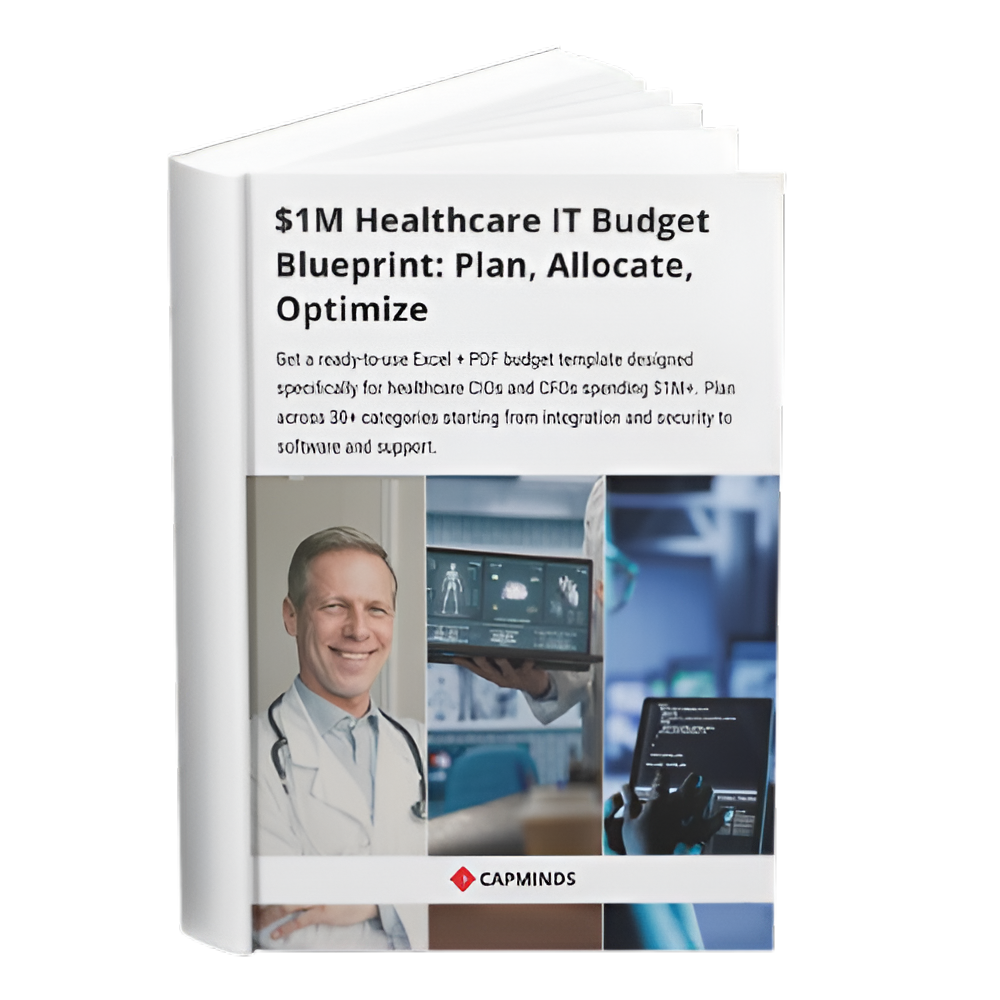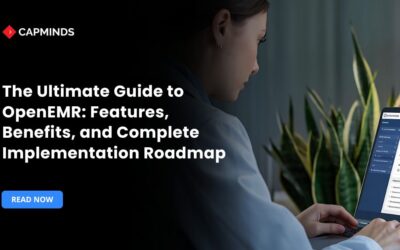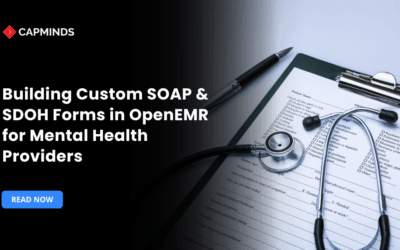What’s New in OpenEMR Development? A Deep Dive Into Recent Improvements
Over the last six months, OpenEMR, the popular open-source electronic medical record platform, has advanced significantly. The community released version 7.0.3 in March 2025. This release was a significant turning point. Better clinical tools, enhanced interoperability, and sophisticated telemedicine, billing, and patient interaction capabilities were all brought about by it.
We’ll go over these enhancements in-depth in this blog. We’ll examine how OpenEMR is developing to enhance user experience, assist clinical workflows, and fortify compliance. We’ll also showcase the enhanced API features, billing improvements, and new security fixes that promote smooth interoperability.
By the conclusion, you’ll learn how the most recent developments in OpenEMR enable administrators and healthcare professionals to confidently tackle the operational and clinical difficulties of today.
6 Major Improvements in OpenEMR Development You Need to Know
1. Streamlined Clinical Workflows
New OpenEMR upgrades prioritize clinicians by streamlining routine tasks. New features and modules reduce administrative burden and let providers focus more on patient care:
Decision Support Interventions (DSI)
OpenEMR can now display evidence-based alerts and suggestions during patient contacts because it fulfills the ONC’s B11 DSI criteria.
For instance, the system can instantly identify any drug problems or inform a doctor about preventive treatment. By assisting physicians in avoiding mistakes, these clever clinical prompts result in safer care and improved documentation.
Integrated e-Prescribing
A new WENO Exchange eRx module allows direct electronic prescribing through OpenEMR.
Prescriptions can be electronically sent to pharmacies by providers without the need for a separate system, particularly in small or rural practices. This guarantees that patients receive their prescriptions more quickly, simplifies medicine administration, and cuts down on phone calls and faxes.
Telehealth Enhancements
For more seamless virtual appointments and video visits, OpenEMR’s integrated telehealth module has been improved. Better reliability and usability allow clinicians to start HIPAA-compliant video sessions directly from the EHR.
Because of this connectivity, virtual visit workflows are managed centrally, increasing access to care without introducing additional complexity.
Patient Flow Board Improvements
The patient flow board, a dashboard tracking where each patient is during their clinic visit, received updates for usability. Employees can more readily view wait times, exam room assignments, and check-in status at a glance.
Real-time patient flow monitoring enables clinics to see bottlenecks (such as lengthy wait times) and make necessary adjustments promptly, enhancing both the overall patient experience and clinic productivity.
New Clinical Forms & Tools
OpenEMR now comes with additional built-in forms and questionnaires to support care delivery. For example, the system now includes a PHQ-9 depression screening form, and other assessment instruments (such as the GAD-7 for anxiety) have been enhanced.
These enable providers to directly record significant patient-reported data in the electronic health record. Combined with general clinical decision rule (CDR) engine improvements, these tools embed best practices into daily workflows.
All these workflow enhancements mean a smoother day for clinicians and staff.
Fewer workarounds or external systems are needed, whether it’s conducting a telehealth visit or following clinical guidelines, because OpenEMR’s latest version brings these capabilities to your fingertips. The result is less time spent on administrative steps and more on patient care.
Related: Implementing e-Prescribing, Lab Interfaces, and Imaging Workflows in OpenEMR
2. Enhanced User Interface and Experience
Using OpenEMR has become more intuitive and efficient thanks to a series of user interface (UI) and user experience (UX) improvements. The developers have modernized the look-and-feel and made navigation easier for busy healthcare teams:
Modern Responsive Design
To make sure it functions properly on all devices, OpenEMR’s interface was redesigned with a responsive layout that makes use of the Bootstrap framework.
- Screens automatically adjust to be viewable and effective whether you’re using a little tablet at your bedside or a large desktop display.
- No more awkward scrolling or tiny text on mobile devices, providers can review charts on a tablet or even check schedules on a phone without hassle.
- This mobile-friendly design is crucial for clinicians on the go and “future-proofs” the system for new devices.
Streamlined Navigation Menus
OpenEMR’s navigation menu has been significantly improved. Users were frequently slowed down by the numerous menus and frequent pop-ups in earlier versions. The most recent design is sleeker and tidier. It now has a unified menu bar with easily readable icons and sections that can be folded up.
Additionally, navigation is role-based. For instance, doctors view clinical modules, while front desk employees access scheduling and billing capabilities. This guarantees that each user is not distracted and only sees the features pertinent to their position.
The experience runs more smoothly as a result. Users concentrate more on their activities and spend less time navigating menus. The streamlined layout reduces the learning curve for new hires. For everyone else, it increases productivity in everyday tasks and lessens annoyance.
Updated Dashboards and Forms
For clarity, key screens have been revamped.
- Important statistics, such as demographics, vitals, and recent history, are now logically grouped together in the patient dashboard (summary view) for easy access.
- The system’s input forms have been improved with uniform styling and streamlined layouts, making the documentation clearer and less prone to errors.
- Smart defaults and clearer labels in forms mean clinicians can chart more quickly with fewer mistakes.
Improved Scheduling Interface
Appointment scheduling, a daily task for any practice, has benefited from UI polishing.
Fixes and enhancements to the calendar and scheduling module have made it simpler to check the day’s schedule, create recurring appointments, and set up provider availability.
A cleaner calendar layout and color-coded statuses assist staff in managing appointments and minimizing overlaps or no-shows. These ostensibly minor design changes result in time savings and fewer scheduling errors.
Patient Portal Usability
While technically part of patient engagement, the portal’s interface got an upgrade that merits mention.
- The OpenEMR interface now has a clearer, easier-to-use layout for patients logging in.
- Records may be easily accessed on any device thanks to the mobile-friendly design.
- Patients may check lab results, upcoming appointments, and messages from their care team with a few touches.
This ease of use keeps patients interested. People are more inclined to use their portal frequently when they can utilize it without any problems.
In addition to increasing patient involvement in care, this involvement lessens the workload for clinic employees. These UI and UX enhancements work together to give OpenEMR a contemporary, patient-focused feel. An easy-to-use EHR reduces errors and saves time in busy clinics and hospitals. Employees undergo less training, enter data incorrectly, and become less “EHR fatigued.”
Healthcare teams can operate more effectively thanks to OpenEMR’s updated interface, which reduces complexity and pointless clicks. They can concentrate on providing high-quality care rather than fumbling with software.
3. Compliance and Security Updates
Keeping patient data secure and meeting regulatory requirements is non-negotiable in healthcare. OpenEMR’s recent development cycle put heavy emphasis on compliance with U.S. standards and strengthening security protections:
Continued ONC Certification
OpenEMR 7.x maintains its status as a 2015 Cures Update Certified EHR, and the project has implemented new rules required by regulators.
- In version 7.0.3, OpenEMR added support for Decision Support Interventions to meet the latest ONC Health IT Certification criteria.
- In the prior update (7.0.2), it also introduced an EHR Export feature that allows practices to export all patient data in a standardized format.
This means OpenEMR users can comply with information blocking rules by providing patients or other providers a complete data export when requested.
The OpenEMR team even published a Real World Testing report for 2025, demonstrating that the software performs as expected in real clinical settings, a requirement for ongoing certification.
Audit Logging and Access Control
OpenEMR has robust audit logs and access control features, and recent improvements bolster these.
- For example, the system added support for login session tokens and improved tracking of login attempts.
- There is now a “maximum failed login” lockout mechanism to enhance security against unauthorized access attempts.
- Administrators can configure account lockout after a certain number of failed attempts, helping to prevent brute-force attacks on user passwords.
- Additionally, OpenEMR fixed and improved features around user authentication, like support for Multi-Factor Authentication, which was patched and refined.
These updates give clinics more peace of mind that only authorized staff can access sensitive records.
Related: Configuring Access Control & Encryption in OpenEMR for Maximum Security
OAuth2 and API Security
As part of its API enhancements, OpenEMR implemented PKCE for OAuth2 in version 7.0.1. This sounds very technical, but essentially it means third-party applications connecting to OpenEMR’s API can do so more securely, reducing the risk of intercepted credentials.
The OAuth2 and SMART on FHIR improvements ensure that integrations with outside apps meet the latest security best practices, which is critical as healthcare data exchange grows.
Routine Security Fixes
The OpenEMR community is vigilant about addressing vulnerabilities. Each release and patch over the last half-year included numerous security fixes, from minor bug fixes to closing potential security gaps.
The software is also kept up-to-date with modern infrastructure: compatibility with the latest PHP 8.1+ versions ensures the platform benefits from the security hardening in newer environments.
For healthcare administrators, this attention to security means OpenEMR remains a trustworthy system for handling PHI (Protected Health Information) and helps your organization stay HIPAA-compliant out of the box.
Related: The Importance of Regular Security Patches & Updates in OpenEMR
4. Advanced Billing and Insurance Features
A significant portion of the recent improvements focus on the financial and administrative side of practice – billing workflows, insurance claims, and revenue cycle management. OpenEMR’s updates aim to streamline these processes so that getting paid is easier and fewer claims “fall through the cracks”:
Claims Clearinghouse Integration
OpenEMR enhanced its electronic billing modules and integration with clearinghouses for claim submission. Through the Claims Clearinghouse module, billers can submit insurance claims electronically in a more seamless fashion.
The 7.0.3 update improved this integration, reducing errors in the generation of X12/837 claim files and enabling better tracking of claim statuses. In practice, this means faster submission of claims and quicker responses from payers, with less manual exporting and uploading of files.
Prior Authorization Workflow
A new Prior Authorization module introduced in the 7.x series helps clinics manage pre-approvals from insurance. Users can initiate and record prior auth requests for procedures or medications and track their outcomes. This workflow support is critical, missing an authorization can lead to denied claims.
By having a dedicated tool inside OpenEMR, staff are prompted to obtain approvals in advance and can document authorization numbers, ensuring smoother downstream billing.
Integrated Payment Processing
The OpenEMR project has added support for processing patient payments directly within the system. Instead of using separate payment terminals or software, front-desk staff can collect payments through OpenEMR’s Payment Processing module and have those transactions immediately tied to the patient’s account. This reduces double entry and makes it easier to reconcile balances.
It’s also convenient for patients, for example, paying their bill via the portal or at check-out can automatically update their invoices in OpenEMR.
Fee Schedules and Billing Codes
Managing what to charge for services is easier now. OpenEMR 7.0.2 introduced the ability to store fee schedules from various payers in the system. Practices can maintain a list of allowed amounts or contracted rates, which helps in setting charges and calculating write-offs accurately. In addition, the billing module and fee sheet saw improvements, for instance, better handling of multiple tax IDs or facility fees, and a more user-friendly fee sheet interface for selecting procedure codes.
OpenEMR also stays current with coding standards: the latest ICD-10 diagnosis codes have been updated in the system, helping avoid denials due to outdated codes.
Insurance and EDI Enhancements
Numerous fixes and enhancements were made around insurance tracking and electronic data interchange. The software’s handling of insurance claims and responses was polished, leading to more reliable posting of insurance payments and adjustments. OpenEMR also improved eligibility checking functions and addressed edge cases in claim formatting. Together, these changes reduce the chance of claims being rejected for technical reasons and reduce manual work for billing staff.
For healthcare businesses, these billing and insurance upgrades translate to real benefits: fewer denied claims, quicker reimbursements, and less time spent on billing paperwork.
By automating and integrating revenue cycle tasks, OpenEMR helps practices improve their financial health. In an era of complex payer rules and razor-thin margins, having an EHR that actively supports your billing workflow is invaluable.
5. Expanded API and FHIR Capabilities
Modern healthcare IT systems must be able to “talk” to other software.
To that end, OpenEMR’s developers have significantly expanded its API and standards-based interoperability support in recent releases. These technical improvements enable better data exchange and integration with other tools, which ultimately benefits providers and patients:
FHIR API Enhancements
Support for FHIR, the contemporary standard for exchanging healthcare data, has been reinforced by OpenEMR. Its FHIR APIs receive significant enhancements and corrections in the 7.0.3 version. Clinical data can now be submitted or retrieved more easily and consistently thanks to these improvements.
- For instance, third-party apps can use FHIR calls to send updates straight into OpenEMR or securely access patient records with permission.
- Care coordination is made safer and more effective by this improved data flow.
- OpenEMR maintains complete alignment with the rapidly expanding ecosystem of wearable technology, health apps, and health information exchanges that depend on the standard by improving FHIR support.
Broader REST API Capabilities
OpenEMR has a strong RESTful API in addition to FHIR. Significant improvements have also been made to this. OpenEMR can now be easily integrated by developers and IT teams with custom mobile apps, appointment reminder services, and hospital information systems.
New endpoints, more data fields, improved performance, and more understandable documentation are all part of the update. These modifications reduce the need for workarounds and speed up processes like syncing with a practice management system or exporting data to a warehouse.
Organizations have more flexibility because of this transparency. It enables them to modify OpenEMR to fit their long-term digital health plans, reporting needs, and workflows.
SMART on FHIR Support
OpenEMR didn’t stop at basic FHIR APIs; it also improved SMART on FHIR integration. SMART on FHIR is a framework that lets authorized third-party apps launch within the EHR context.
The updates in the last six months ensure that launching and using SMART apps is smoother, with refined OAuth2 authorization and single sign-on experience. For a provider, this means they could, for instance, use a specialized risk calculator or population health tool within OpenEMR without juggling separate logins or exporting data. It’s all integrated securely via standard protocols.
Use Cases for Connectivity
What do these API and FHIR upgrades mean in day-to-day terms? In short, OpenEMR is becoming a more connected and interoperable system.
- A clinic could link OpenEMR to a lab system so lab results flow in automatically.
- A hospital could feed OpenEMR data into a business intelligence dashboard to analyze clinical quality metrics.
- Practices can connect OpenEMR with clearinghouse and billing services or with state immunization registries to report vaccines, all thanks to robust APIs.
- By expanding these capabilities, OpenEMR keeps up with the industry trend of data-driven care and analytics.
As the ClaimRev team noted, the stronger API support “makes it easier for providers to connect OpenEMR to other tools, like clearinghouses, analytics platforms, and billing software”, unlocking opportunities to streamline many processes through integration.
6. Interoperability and Data Exchange Tools
Interoperability goes beyond APIs – it’s also about built-in tools that allow sharing of health information with other providers, patients, and systems. OpenEMR’s recent improvements include several features that facilitate smoother data exchange and collaboration:
CCDA Import/Export Improvements
OpenEMR has long supported CCDA (Consolidated Clinical Document Architecture), a standard format for summary medical records. In the latest updates, the CCDA capabilities were improved.
This includes a more reliable CCDA import utility for bringing in patient records from other EHRs. The import process is now easier and handles more variations of CCDA files, reducing the time staff spend reconciling outside records.
Clinics can also export patient summaries in CCDA format to share with referral partners or to give patients a portable record. By supporting standardized documents, OpenEMR ensures continuity of care when patients see multiple providers.
Direct Messaging (Secure Email)
OpenEMR includes a Direct Messaging module, this is the encrypted email system used in healthcare to send patient data (think of it like clinical email). Recent fixes to Direct Messaging make sending and receiving messages more reliable.
A provider can, for instance, send a referral note or a care summary to another clinician on the Direct network straight from OpenEMR, or receive one into OpenEMR’s inbox. The ability to share records electronically in this manner helps replace faxing in care coordination, aligning with modern interoperability standards and saving time.
Electronic Health Information Export
As mentioned under compliance, OpenEMR added a comprehensive EHI Export tool. This feature isn’t just about certification, it’s a practical utility to export an entire patient’s record in one go. In scenarios like a patient requesting their records, migrating to another system, or doing a data analysis project, having a one-click export of all data is invaluable.
OpenEMR’s EHI exporter packages data and documents into a standardized zip file. This level of data portability reflects a real commitment to interoperability and data ownership rights, users aren’t locked in and can get their data out when needed.
Integration with External Services
OpenEMR’s modular design means new connectors can be added, and indeed several modules have been maintained or improved that connect to outside services. For example, the system can interface with external pharmacy networks via eRx, connect to SMS gateways to send patient reminders, and link to fax services to send/receive documents.
Laboratory ordering and results integration have patches applied as well, ensuring that lab orders from OpenEMR and incoming results flow correctly. Each of these interoperability points has seen attention in the past months, addressing minor glitches and keeping the data flowing smoothly between OpenEMR and other health IT systems.
Related: Achieving Interoperability at Scale: HL7, FHIR, and API Integrations with OpenEMR
Complete OpenEMR Service Solutions for Modern Healthcare
At CapMinds, we don’t just follow OpenEMR’s growth, we help you harness it to its fullest potential.
With the latest advancements in OpenEMR, healthcare organizations require a trusted partner who can implement, customize, and optimize these capabilities to achieve real-world impact.
That’s where our Complete OpenEMR Services come in.
With CapMinds, you gain:
- OpenEMR Implementation Services – Seamless deployment tailored to your practice’s unique needs.
- OpenEMR Customization Services – Clinical workflows, forms, and modules built around your specialty.
- OpenEMR Integration Services – Connect labs, billing, telehealth, and third-party systems with ease.
- OpenEMR Compliance & Security Services – HIPAA-ready configurations and enterprise-grade protection.
- OpenEMR Support & Maintenance Services – Ongoing upgrades, monitoring, and issue resolution.
CapMinds empowers healthcare practices, hospitals, and private clinics to stay ahead of compliance, deliver better patient care, and streamline operations.
Ready to unlock the full potential of OpenEMR? Let’s build your future-ready EHR today.
👉 Book a free OpenEMR consultation with CapMinds experts now!




